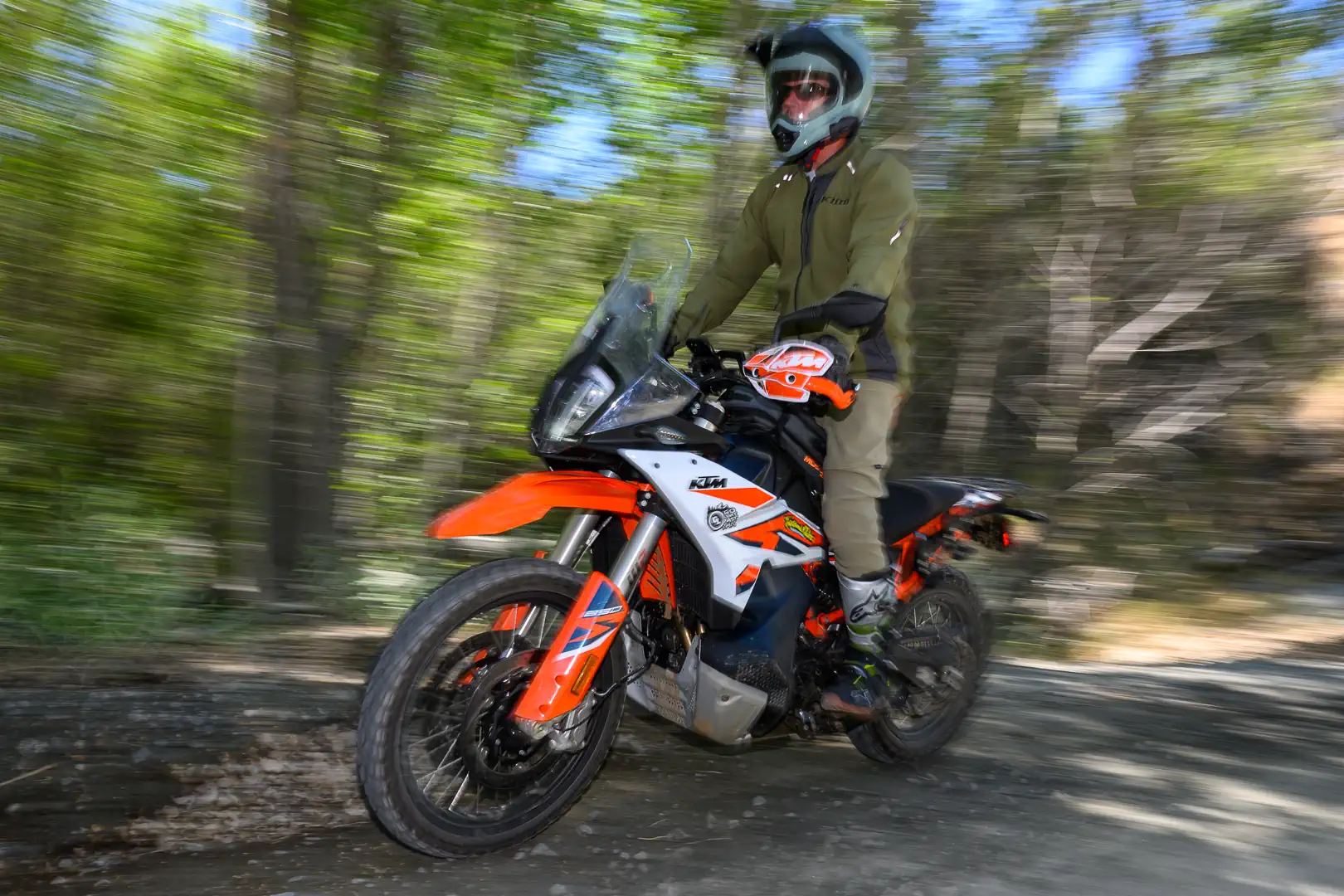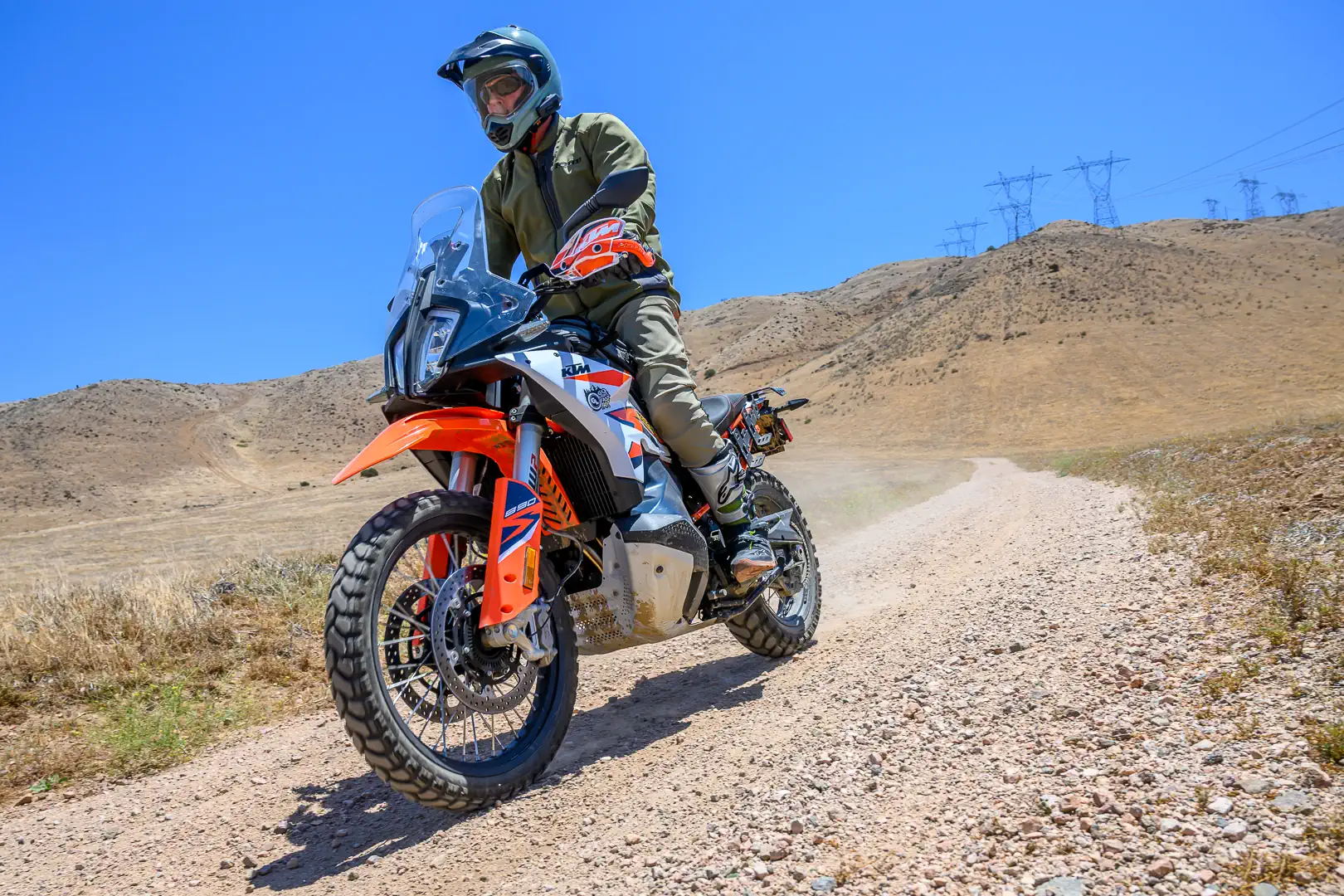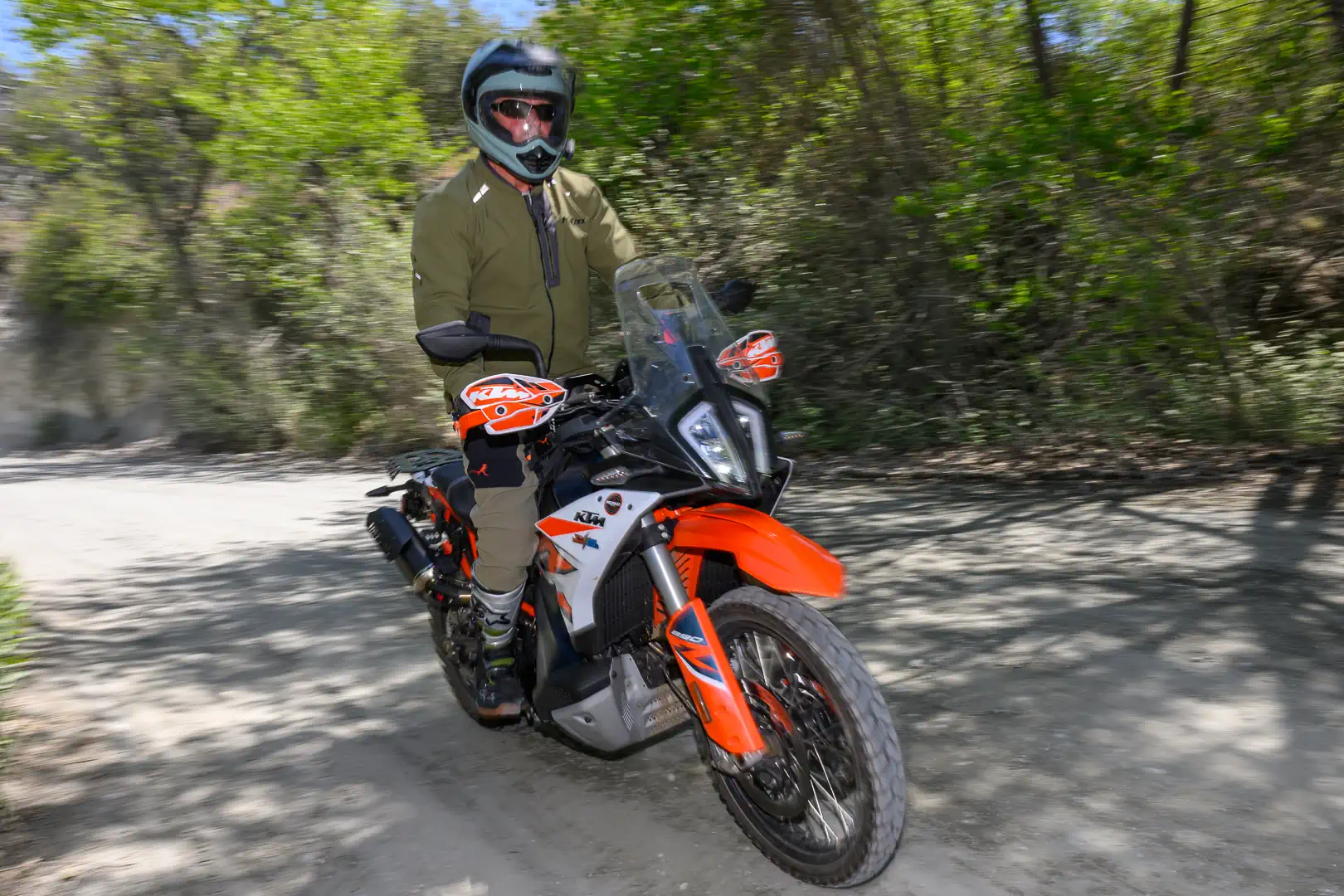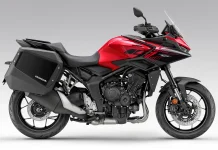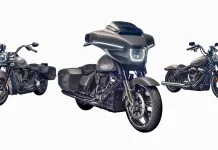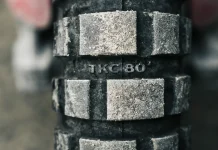Freeman Wood, our restless Associate Editor, is at it again, reimagining a KTM 890 Adventure R for touring on pavement and rugged trails alike. Where this build leads, nobody knows—yet. Follow along!
The desert night was pitch black. I stood on the potholed dirt driveway of the Pioneertown Motel in the Mojave Desert, tucked behind Pappy & Harriet’s Pioneertown Palace. Lying on its side in front of me was my fully loaded 2017 Triumph Tiger 1200 Explorer. I had stopped to figure out which road led to the motel parking and, unfortunately, found a pothole with my 31-inch inseam. While the Tiger’s seat height wasn’t excessively high, once a 600-pound, fully loaded motorcycle starts to tip, stopping it without both feet firmly planted is nearly impossible.
After multiple attempts, I realized I couldn’t pick it up without fully unloading it in the dark—what a pain.
The Tiger had been my long-term cross-country travel companion, and, for the most part, it was a fantastic bike. However, it had two significant flaws. It ran hot (think roasted nether regions), and it was incredibly top-heavy. Add two weeks’ worth of gear, and it became unmanageable on off-camber or technical terrain. Right there, in that dusty driveway, I decided—the bike had to go.
I am still hunting for the perfect adventure touring partner that balances long-distance comfort with serious off-road capability. I have our 2024 Triumph Tiger 1200 Rally Pro Project Bike in my garage, but it’s cumbersome for technical off-road riding. That realization has led me to the same conclusion as a vast portion of the adventure motorcycle market—middleweight adventure bikes are where it’s at.
The Search for the Right Bike
As I began my search, two challenges emerged. The first, ironically, is a good problem. The middleweight adventure segment is packed with fantastic options, making it tough to pick the right bike. The second challenge, however, is trickier. Nearly all the top middleweight contenders have tall seat heights because of their off-road-biased suspension setups.
I had my eye on a few models. After spending a week on a Husqvarna Norden 901 Expedition and riding my buddy’s new KTM 790 Adventure, I was drawn to KTM’s compact feel, off-road control, and lively engine. I ultimately landed on the KTM 890 Adventure R—a bike with an excellent spec sheet, a solid reputation, and a reasonable price tag.
However, its biggest drawback is its seat height. At 34.5 inches, I was still on my tiptoes on the KTM 890 Adventure R. Dropping nearly 100 pounds by moving from a full-size ADV bike to a middleweight definitely helped with handling, but I still didn’t like that tippy-toe feeling when straddling the bike. I needed a way to shave off a couple of inches. Thankfully, I developed some solutions.
Lowering the KTM 890 Adventure R
The first thing that caught my eye was a suspension lowering kit. Touratech sells an affordable ($400), straightforward solution—its Progressive Fork & Shock Spring Kit. The kit includes progressive-rate springs for the fork and shock, plus replacement fork oil.
The springs have a softer initial compression, allowing the chassis to settle about 1.2 inches lower under load. It’s a relatively easy modification that doesn’t require major mechanical changes—perfect.
While swapping springs and replacing fork oil aren’t overly complicated jobs, I opted to have Thousand Oaks Powersports handle the installation to ensure it was done right.
Next, I turned to the seat. KTM and various aftermarket brands offer low-seat options. I settled on the Seat Concepts Comfort Low seat. My colleague Associate Editor Neil Wyenn had tested the standard Comfort seat on the Ultimate Motorcycling Yamaha Ténéré 700 Project Bike, and came away impressed. The Comfort Low seat sits nearly an inch lower than stock by using thinner, firmer padding.
The Seat Concepts Comfort Low seat is plug-and-play—perfectly compatible with the bike’s stock mounting points. I got the version available with orange stitching that matches the 890 Adventure R’s color scheme beautifully—a nice bonus.
Unpacking the seat, I was impressed with the craftsmanship. It was noticeably wider in the rear, which I hoped would help with comfort despite the reduced padding.
Interstate Testing
With the suspension lowered and the new seat installed, it was time to ride. Winter in Southern California means prime desert riding conditions—cooler temps and fewer crowds. I packed up the bike and headed for Joshua Tree—a two-hour-plus grind on SoCal freeways.
The first thing I noticed when hopping on the bike was the sag. Sitting on the bike with the progressive-rate springs and lower seat, I was nearly flat-footed—an important improvement over stock.
I had to remove the kickstand puck I had previously installed, as the bike wouldn’t lean over far enough for my comfort after being lowered. A shorter or adjustable kickstand may be on the list for the KTM 890 Adventure R Project Bike.
On the freeway, the suspension is firm, though not drastically different from stock. The Seat Concepts Comfort Low seat is, indeed, low. However, after an hour, the minimal padding becomes noticeable and now quite as comfortable. Of course, the stock KTM seat isn’t known for comfort, so it wasn’t a huge departure. The wider rear section allowed me to shift around when needed, reinforcing the Comfort claim.
Off-Road Testing
Once in the desert, I spent a few days hitting familiar trails—sandy dirt roads, rutted hill climbs, and a mix of technical terrain. The KTM 890 Adventure R felt right at home. I was covering ground as fast as I could on lighter, more dirt-focused bikes.
The suspension still felt stiff, and the ride was not as planted as I had hoped. I spent a fair amount of time fiddling with the Touratech spring preload, which revealed an interesting relation with the softer progressive springs. The softer progressive rate springs’ initial rate creates more sag, which lowers the seat height. However, it also moves the WP Apex Progressive Damping System shock through the softer part of its travel. To compensate, I tried increasing the spring preload.
Finding the right balance is key and requires experimentation. I needed enough preload to improve shock performance/stability without losing the seat height reduction I’d just gained.
Eventually, I had to accept the increase in suspension stiffness would remain, because the softer part of the springs and WP shock damping was taken out of the suspension equation.
In the dirt, the Seat Concepts saddle performs well. The narrow front helps with footing, while the firm feel isn’t an issue because I spend much of the ride standing. I expect the seat to soften slightly over time, improving long-distance comfort.
Wrapping Up Part 1
Since those first desert rides, I’ve taken the KTM 890 Adventure R Project Bike on dirt trails and fire roads in various places, and I love its capabilities.
I have since found the ideal balance of preload. The setup puts me slightly on the balls of my feet rather than fully flat-footed, which hasn’t been an issue. While the suspension isn’t as plush as some other bikes, it is primarily noticeable on small bumps and ruts. Big hits and technical terrain are still handled fantastically. Overall, the changes were inexpensive, simple to install, and achieved my desired ride height.
Now, it’s time to rack up the miles, see how the setup ages, and think about other mods.
KTM 890 Adventure R Project Bike Part 2, June 2025
After successfully modifying the suspension and seat on my KTM 890 Adventure R to lower the stand-over height, I set my sights on additional upgrades to better suit the bike for adventure riding. At the top of the list was addressing the exhaust system, an area where I saw considerable potential for improvement.
The KTM LC8c engine has thoroughly impressed me with its light weight, linear power delivery, and lively character. However, I’ve never quite warmed to the stock exhaust note which I find a bit subdued and flat for an adventure bike of this caliber.
Drawing from past experiences with exhaust swaps on multiple bikes, I knew that an aftermarket system could deliver three main advantages, particularly when combined with catalytic converter removal (strictly for track use, of course): meaningful weight reduction, a more engaging and aggressive exhaust sound, and potential improvements in throttle response and midrange power.
As I began researching options, I connected with Moto Machines, a family-owned importer and retailer based in Virginia since 2011. They recommended a setup using the Scorpion Serket Parallel Slip-On muffler ($685) paired with a Scorpion De-Cat Link Pipe ($180) to eliminate the catalytic converter.
The projected weight savings were good—eight pounds total, with more than a pound coming from the slip-on itself and a substantial seven pounds from ditching the catalytic converter. On a machine that weighs just under 470 pounds wet, shedding eight pounds is noticeable, especially off-road.
Moto Machines shipped the parts quickly, and the installation process was straightforward, thanks in part to some detailed YouTube walkthroughs. The only minor snag I encountered was difficulty aligning the mid-pipe flange to the frame connection point. Whether this was due to a slight manufacturing tolerance issue or (more likely) user installation error, it turned out to be a non-issue. The mid-pipe is very lightweight, and the robust connections between the slip-on, the headers, and the bike ensured the system remained securely mounted without the intermediate bracket.
The moment of truth came when I fired up the engine of the Ultimate Motorcycling KTM 890 Adventure R Project Bike. At idle, the noticeably deeper sound was subtle. However, under throttle, the exhaust note transformed into something far more satisfying—throaty, assertive, and much more in line with the KTM’s Ready To Race character.
Out on the road and trail, the system worked flawlessly. I noticed an improvement in throttle response and midrange pull, with no perceptible fueling issues or hesitation, even with the stock ECU.
After a few rides, curiosity got the better of me, and I removed the dB-killer baffle from the slip-on. The result? Instant grin factor. If you’re unconcerned about keeping your neighbors happy and can tolerate a fairly loud idle, run it without the baffle. On the trail, the exhaust note becomes addictive—deep, raw, and brimming with character, transforming the ride into a much more immersive experience.
With the exhaust sorted, I turned to other key upgrades to optimize the bike for long-distance adventure travel.
From the extensive KTM PowerParts catalog, I selected a larger touring windscreen ($311) and CRM Probend Ultra handguards ($221/pair) for added wind and impact protection. Given my height—5-foot-11 with a long torso—I added a Puig Multi-Adjustable Visor ($120) to the top of the larger screen to reduce helmet buffeting at highway speeds. The larger windscreen mounts solidly and provides a stable, vibration-free base for the extension, which dramatically improves comfort on long rides.
KTM Twins’ 47mm KTM Handlebar Mount Kit ($64) significantly improves ergonomics when riding in a standing position—an important consideration for off-road sections where proper weight distribution and balance are critical.
As I love touring, I had to make it easier to bring cargo along. I installed a Perun Moto large billet tail rack ($159). Made in Serbia, it’s an excellent addition that provides a strong platform for soft luggage or a duffle bag. I’m also in the process of testing Perun Moto’s luggage rails ($129/pair), which require removing the rear side panels.
Finally, I needed a tank bag to hold my smaller adventure essentials, including tools, snacks, electronics, and maps. Typically, I prefer minimalist, waterproof single-compartment bags. However, my riding buddy Snake wouldn’t stop raving about his Mosko Moto tank bag, so I decided to give the Nomax V3.0 tank bag ($299) a try. My colleague Neil Wyenn tested an earlier Nomax tank bag on the Ultimate Motorcycling Yamaha Ténéré 700 Project Bike.
What sealed the deal on the Nomax V3 tank bag was the Onyx/Orange color scheme, which perfectly matches the KTM 890 Adventure R. Already owning a Mosko Moto duffle, I knew the company doesn’t mess around—their gear is exceptionally well-designed and built.
With multiple layers of organized storage, excellent expandability, a water-resistant DWR coating paired with a rain cover, and an integrated two-liter hydration bladder, the Nomax V3.0 tank bag is an ideal solution for adventure travel, combining practicality, durability, and thoughtful design with MOLLE compatibility.
With these upgrades complete, the bike now feels dialed in and ready to tackle my Colorado adventure trip this month. I’ll report back after the ride to share how all the modifications performed in the wild. Bookmark this page!














